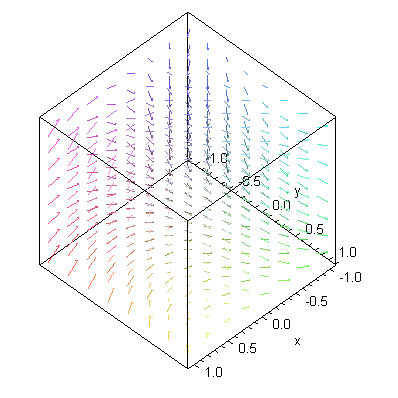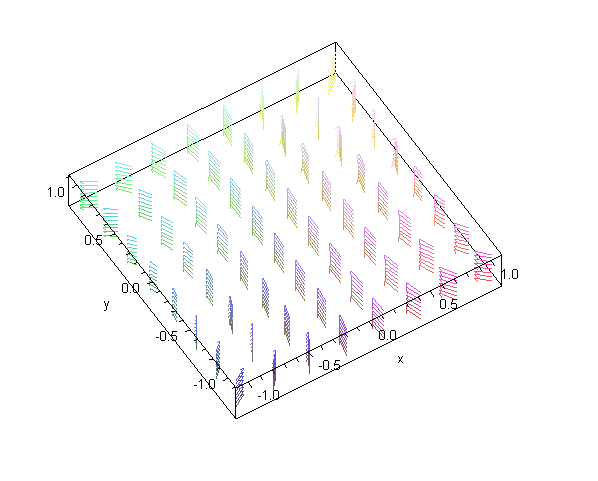www.jb-electronics.de » Programmieren » Maple » Vektorfelder
Vektorfelder
Vektorfelder sind Funktionen, bei denen ein Ortsvektor auf einen Vektor abgebildet wird. Anders ausgedrückt: Jedem Ort im Raum wird ein Vektor zugeordnet.
Es ist relativ schwer, sich gegebene Vektorfelder graphisch vorzustellen. Doch zum Glück schafft Maple da Abhilfe: Der fieldplot- bzw. fieldplot3d-Befehl.
fieldplot (zweidimensional)
fieldplot kann benutzt werden, um ein zweidimensionales Vektorfeld zu zeichnen. Betrachten wir folgendes Beispiel:
- # Neu starten und Plot-Paket einbinden
- restart;
- with (plots);
Dann definieren wir unser zweidimensionales Vektorfeld:
- # Vektorfeld definieren
- f := (x, y) -> Vector([sin(x) * y, cos(x)]);
Das plotten wir nun in Maple wiefolgt:
- # Plot erstellen
- fieldplot(f(x, y), x=-1..1, y=-1..1);
Der erste Parameter gibt das Vektorfeld an (Argumente nicht vergessen!), der zweite und dritte Parameter geben die Grenzen des darzustellenden Intervalls an. Hier ist das Ergebnis zu sehen:

Anscheinend sorgen die trigonometrischen Terme (sin, cos) für Wirbel im Feld.
Das Maple-Skript gibt es hier zum Download: fieldplot.mw (17 KB).
fieldplot3d (dreidimensional)
fieldplot3d muss hingegen benutzt werden, wenn dreidimensionale Vektorfelder gezeichnet werden sollen. Wieder ein Beispiel:
- # Neu starten und Plot-Paket einbinden
- restart;
- with (plots);
Dann definieren wir unser nun dreidimensionales Vektorfeld:
- # Vektorfeld definieren
- f := (x, y, z) -> Vector([sin(x) * y, cos(x), z^2 + x]);
Das plotten wir nun in Maple analog zum zweidimensionalen Fall, allerdings jetzt unter Verwendung des fieldplot3d-Befehls, und unter Angabe eines dreidimensionalen Intervalls:
- # Plot erstellen
- fieldplot3d(f(x, y, z), x=-1..1, y=-1..1, z=-1..1, axes=boxed);
Zudem lassen wir uns noch eine Box darum anzeigen für bessere Übersichtlichkeit:

Dieses kann auch mit der Maus gedreht werden, sodass mensch sich einen guten Eindruck von den Beschaffenheiten des Feldes machen kann:

Besonders interessant ist diese Ansicht:

Es lassen sich auf einmal Symmetrien erkennen, die beim Betrachten der mathematischen Beschreibung des Feldes gar nicht so sehr auffallen. Insgesamt ist der fieldplot-Befehl also sehr praktisch.
Das Maple-Skript gibt es hier zum Download: fieldplot3d.mw (17 KB).
Anwendungen dieses Befehls sind zum Beispiel in der Physik die Auswertung und Analyse von Strömungsfeldern.